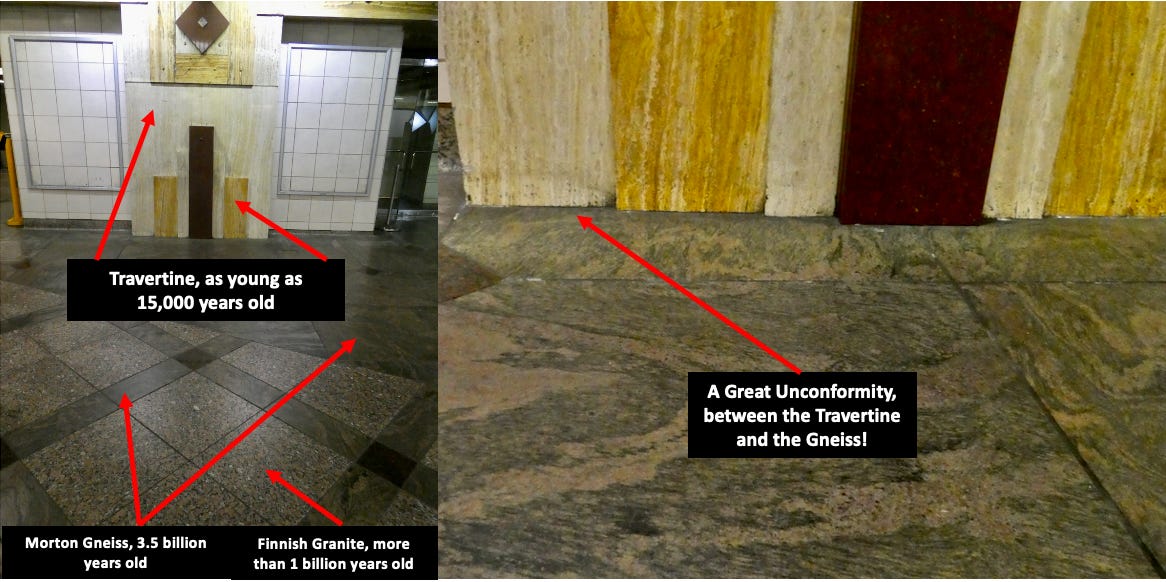One of my favorite places to see urban geology in Seattle is in the downtown corridor’s Light Rail stations. In particular, the one under Westlake Mall has rock ranging in age from tens of thousands of years old (travertine from New Mexico) to 3.5 billion years old (gneiss from Morton, Minnesota.) To a geologist, this station is a pleasure ground but it also a bit disturbing because geologically juxtaposed rocks such as the travertine and gneiss are an unconformity, or a missing time gap.
Although common in the natural world though rarely with such age disparity, unconformities also present a problem forcing us to wonder how to explain the gap. In the wild, we look for clues—erosional features, faults, and the like. In the city, we mostly just enjoy the gap (“Mind the gap,” as Tube riders would say.) and point out to others the curiosity of what we see. In Seattle though there’s a missing piece of the geological story that has nothing to do with geology and everything to do with politics.
In January 1989, local newspapers reported that Metro, the King County agency building what were then bus stations, would have to pay for, but not use, a half million dollars worth of stone that it had purchased for the bus tunnel through the urban core. The troubles began when Eddie Rye of the Black Contractors Coalition notified Metro about its planned use of rock quarried in South Africa. The reason for the rejection was that the County had a policy prohibiting the use or purchase of any goods “manufactured or fabricated” in South Africa because of apartheid.
Quarried near Bitterfontein, about 200 miles north of Cape Town, the pine green stone, known in the trade as Verde Fontaine and usually referred to as a granite, formed over one billion years ago. The green color comes from the mineral chlorite, which forms from the alteration of iron- and magnesium-rich minerals within the rock. Technically, though, the rock is not granite but charnockite, a curious type of rock long thought to have an igneous origin but now described as metamorphic, which I am sure shocks many of you. (The name comes from the tombstone of Job Charnock, an English functionary in India; more than a century after he died geologist Thomas Holland examined the tombstone and coined the term for a rock unlike any he had encountered.)
After Rye blew the whistle, officials within Metro described how some employees had known about the origin of the stone but that they thought that so little would be used that it wouldn’t be a problem. They also noted that use of the rock technically wasn’t illegal because it was only quarried in South Africa but cut and finished in Italy. King County Council Chairman Ron Sims, a member of the Metro Council, responded “It was a morally repugnant decision. Somebody should have to account for that. This was no longer a half-million-dollar ‘error.’ It was a conscious decision to defy public sentiment.”
Accusations continued over the next month ultimately leading to the resignation of Alan Gibbs in late February. ”The buck stops with me,” Gibbs said at a news conference where he read a formal letter of resignation.
“The events of the last few weeks surrounding the issue of South African granite have been an embarrassment to the agency … This episode needs to be put to rest so the agency can move ahead with the important work before us.” Two weeks after Gibbs’ resignation, an internal review of Metro concluded that Gibbs had not misled the public. On September 15, 1990, the bus tunnels under Seattle opened, with walls covered in less polemical and wonderfully interesting and beautiful rock.
I have no idea what happened to the half million dollars of South African charnockite. Someone’s backyard, perhaps?
N.B. - Part of this story originally appeared in my book The Seattle Street Smart Naturalist.
In case you are interested, you can see Verde Fontaine in Seattle. The stone was used on the Washington Federal Savings bank building on the southwest corner of 5th Avenue and Pike Street. The bank was built several years prior to the bus tunnel controversy.







